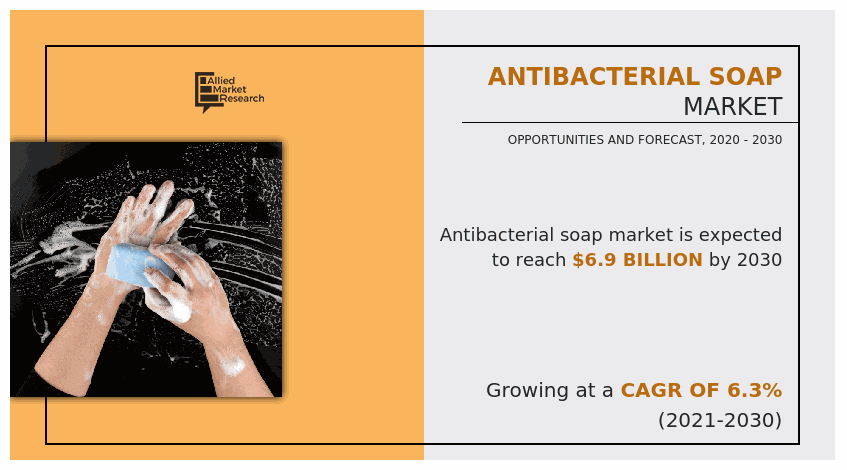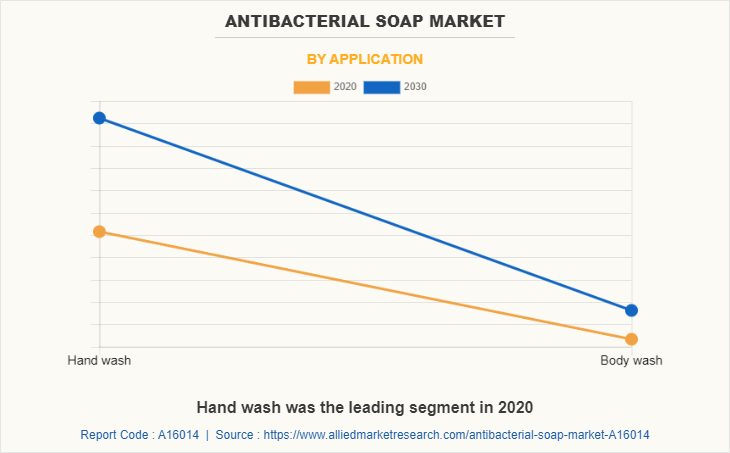Antibacterial Soap Market Research, 2030
The global antibacterial soap market was valued at $3.7 billion in 2020, and is projected to reach $6.9 billion by 2030, growing at a CAGR of 6.3% from 2021 to 2030.

Antibacterial soap is used for cleaning and disinfecting hands and body. The global antibacterial soap market size is expected to witness significant growth, owing to increase in burden of infectious diseases, rise in health-conscious people, and growth in awareness regarding health benefits of using antibacterial soaps. According to the World Bank, maintaining hygiene can significantly reduce healthcare expenses. Washing hands reduces the risks of respiratory diseases among the population by 16% – 20%. According to the Centers for Disease Control and Prevention (CDC), washing hands with soap and water can reduce deaths caused due to diarrhea by 50%. Implementation of initiatives by the government, schools, and NGOs and various campaigns of the manufacturers to spread awareness regarding personal hygiene and handwashing boost the growth of the antibacterial soap market during the forecast period.
Rise in investments in R&D to promote adoption of the herbal and organic ingredients in the antibacterial soaps and regular product launches in varied fragrances boosts the sales of antibacterial soaps. For instance, Lifebuoy, a top antibacterial soap brand of Unilever entered into a partnership with TESCO stores, in February 2020, to provide hand wash liquid soaps to adopted schools of TESCO during the pandemic. Furthermore, increase in awareness among population and health professionals regarding the healthcare associated infections drives the demand for antibacterial soaps across hospitals and clinics. Moreover, rise in health awareness fuels the adoption of the antibacterial soaps in the food service units, including restaurants, hotels, and cafes across the globe.
As per the antibacterial soap market forecast, the market is segmented on the basis of form, application, distribution channel, and region. Depending on the form, it is segregated into bar, powder, and liquid. According to application, it is divided into hand wash and body wash. As per the distribution channel, it is categorized into supermarket & hypermarket, pharmacy stores, online sales, and other channels. Region-wise, it is analyzed across North America (the U.S., Canada, and Mexico), Europe (the UK, Germany, France, Italy, Spain, Russia, and rest of Europe), Asia-Pacific (China, Japan, India, South Korea, Australia, and rest of Asia-Pacific), and LAMEA (Brazil, Argentina, South Africa, Saudi Arabia, and rest of LAMEA).

Depending on form, the liquid segment dominated the global market, accounting for 61.1% of the antibacterial soap market share in 2020. Increase in preferences for the liquid soaps among the consumers, owing to easy usage and convenience associated with liquid soap fuels the growth of the market. Surge in demand for from the healthcare sector is expected to boost the requirement for antibacterial soaps in the future.

According to application, the hand wash segment dominated the antibacterial soap market demand. Increase in awareness regarding health benefits of washing hands contributes in the growth of the market. Rise in demand for handwashing to prevent infections and diseases caused due to contaminated hands results in the dominance of the hand wash segment.

As per the distribution channel, the online sales segment is expected to foresee fastest growth during the forecast period. This is attributable to the growth in adoption of smartphones, rise in penetration of internet, increase in adoption of the e-commerce platforms among the consumers, and convenience of shopping from home are the primary factors that foster the growth of the online sales segment in the global market.

Region-wise, Asia-Pacific is expected to exhibit significant growth, owing to various factors, including increase in population, rise in health awareness, urbanization, surge in penetration of liquid antibacterial soaps, growth in disposable income, improvement in standards of living, and rise in prevalence of infectious diseases.
Players operating in global antibacterial soap industry have adopted various developmental strategies to expand their market share, exploit the antibacterial soap market opportunities, and increase their profitability in the market. The key players profiled in this report include 3M, Amway Corporation, Godrej Consumer Products Limited, GOJO Industries, Inc., Henkel AG & Co. KGaA, ITC Ltd., Reckitt-Benckiser Group PLC. , The Procter & Gamble Company, Unilever Plc., and Vi-Jon.
Key Benefits For Stakeholders
- This report provides a quantitative analysis of the market segments, current trends, estimations, and dynamics of the antibacterial soap market analysis from 2020 to 2030 to identify the prevailing antibacterial soap market opportunity.
- The market research is offered along with information related to key drivers, restraints, and opportunities.
- Porter's five forces analysis highlights the potency of buyers and suppliers to enable stakeholders make profit-oriented business decisions and strengthen their supplier-buyer network.
- In-depth analysis of the antibacterial soap market segmentation assists to determine the prevailing market opportunities.
- Major countries in each region are mapped according to their revenue contribution to the global market.
- Market player positioning facilitates benchmarking and provides a clear understanding of the present position of the market players.
- The report includes the analysis of the regional as well as global antibacterial soap market trends, key players, market segments, application areas, and antibacterial soap market growth strategies.
Antibacterial Soap Market Report Highlights
| Aspects | Details |
| By Form |
|
| By Application |
|
| By Distribution Channel |
|
| By Region |
|
| Key Market Players | gojo industries, Reckitt Benckiser Group, Henkel AG & Co KGaA, Vi-Jon, ITC Ltd, Unilever plc, 3M, Godrej Consumer Products Ltd, amway corporation, Procter & Gamble Co. |
Analyst Review
Based on the insights of the top CXOs, the factor that drives the growth of the market includes different campaigns initiated by top manufacturers and brands to promote various social issues, including health & hygiene awareness, education, and sustainability. Reckitt-Benckiser, in March 2019, launched a campaign named Surakshit Parivar in South India. The aim of this campaign was to promote and create awareness regarding the benefits of hygiene. Dettol brand of Reckitt-Benckiser developed perception that Dettol means protection from germs. This kind of corporate social responsibility in developing markets is expected to offer lucrative growth opportunities to players. The modern day consumers are highly captivated by the social and environmental concerns, which the market players are leveraging to promote their brands in the markets.
Furthermore, various government initiatives to promote hygiene and cleanliness, including the Swachh Bharat Mission by the Government of India play a crucial role in the growth of the antibacterial soap market. According to the Press Information Bureau, the sanitization coverage in rural India increased from 39% in 2014 to 76% in 2018, after the launch of the Swachh Bharat Mission.
The global antibacterial soap market size was valued at $3,733.9 million in 2020, and is estimated to reach $6,924.9 million by 2030, registering a CAGR of 6.3% from 2021 to 2030.
The forecast period calculated in the global Antibacterial Soap market report is 2021 to 2030. Rising consumer awareness regarding the health benefits of using antibacterial soap and the easy availability of the antibacterial soaps in the market are expected to foster the market growth.
The base year calculated in the report is 2020. The year 2020 was an exceptional year characterized by the outbreak of the COVID-19 pandemic. The report provides a detailed analysis regarding the impact of the COVID-19 on the global Antibacterial Soap market.
The key players profiled in this report include 3M, Amway Corporation, Godrej Consumer Products Limited, GOJO Industries, Inc., Henkel AG & Co. KGaA, ITC Ltd., Reckitt-Benckiser Group PLC. , The Procter & Gamble Company, Unilever Plc., and Vi-Jon.
Depending on form, the liquid segment dominated the global market, accounting for 61.1% of the antibacterial soap market share in 2020. Increase in preferences for the liquid soaps among the consumers, owing to easy usage and convenience associated with liquid soap fuels the growth of the market.
North America held the largest market share in 2020. This is attributed to the increased demand for the liquid antibacterial soaps for hand wash and body wash across the region.
Players operating in global antibacterial soap industry have adopted various developmental strategies to expand their market share, exploit the antibacterial soap market opportunities, and increase their profitability in the market.
The global antibacterial soap market size was valued at $3,733.9 million in 2020, and is estimated to reach $6,924.9 million by 2030, registering a CAGR of 6.3% from 2021 to 2030.
Loading Table Of Content...



